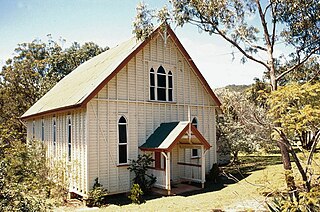
Yungaburra is a rural town and locality in the Tablelands Region, Queensland, Australia. In the 2016 census, Yungaburra had a population of 1,239 people.

Crows Nest Post Office is a heritage-listed post office at 19 Curnow Street, Crows Nest, Toowoomba Region, Queensland, Australia. It was built in 1911. It was added to the Queensland Heritage Register on 27 June 2003.

Childers Post Office is a heritage-listed former post office at Bruce Highway, Childers, Bundaberg Region, Queensland, Australia. It was designed by Queensland Colonial Architect's Office and built from 1890 to 1910. It is also known as Childers Heritage Shop. It was added to the Queensland Heritage Register on 24 January 2003.

Atherton State School Head Teacher's Residence is a heritage-listed school residence at 42 Mable Street, Atherton, Tablelands Region, Queensland, Australia. It was designed and built by the Queensland Department of Public Works in 1913. It is also known as Atherton Provisional School, Enterprise House, and former Principal's Residence. It was added to the Queensland Heritage Register on 21 October 1992.

Herberton Uniting Church is a heritage-listed church at 2-4 Lillian Street, Herberton, Tablelands Region, Queensland, Australia. It was built in 1891 by R Petersens. It is also known as Herberton Presbyterian Church. It was added to the Queensland Heritage Register on 27 August 1999.

St James Catholic Church is a heritage-listed Roman Catholic church at Monash Avenue, Malanda, Tablelands Region, Queensland, Australia. It was designed by Bob Hassall and built by Alby Halfpapp from 1925 to 1926. It was added to the Queensland Heritage Register on 28 July 2000. The church is part of the Roman Catholic Parish of Malanda.

Bank of New South Wales is a heritage-listed former bank building at 27 Atherton Road, Yungaburra, Tablelands Region, Queensland, Australia. It was built c. 1914. It was added to the Queensland Heritage Register on 21 October 1992.

St Marks Anglican Church is a heritage-listed church at 7 Eacham Road, Yungaburra, Tablelands Region, Queensland, Australia. It was built in 1912. It is also known as St Marks Church of England. It was added to the Queensland Heritage Register on 21 October 1992.

Lake Eacham Hotel is a heritage-listed hotel at 6-8 Kehoe Place, Yungaburra, Tablelands Region, Queensland, Australia. It was built in 1910 by Side Brothers. It was added to the Queensland Heritage Register on 21 October 1992.

Cairns Plywood Pty Ltd Sawmill Complex is a heritage-listed sawmill at 25 – 33 Eacham Road, Yungaburra, Tablelands Region, Queensland, Australia. It was built from 1910 to 1980s. It is also known as Cairns Plywood Limited, Eacham Sawmills, and Williamson Brothers Sawmill. It was added to the Queensland Heritage Register on 21 October 1992.

St Patrick's Catholic Church is a heritage-listed church at 1 Penda Street, Yungaburra, Tablelands Region, Queensland, Australia. It was built from 1914 to 1930s. It is also known as Our Lady of Ransom. The church is part of the Roman Catholic Diocese of Cairns. It was added to the Queensland Heritage Register on 21 October 1992.

Yungaburra Court House is a heritage-listed courthouse at 6 - 10 Cedar Street, Yungaburra, Tablelands Region, Queensland, Australia. It was built from 1909 to 1921. It is also known as Court of Petty Sessions. It was added to the Queensland Heritage Register on 21 October 1992.

Eden House Restaurant is a heritage-listed detached house at 20 Gillies Highway, Yungaburra, Tablelands Region, Queensland, Australia. It was built c. 1914. It is also known as Nibbles Tea House. It was added to the Queensland Heritage Register on 21 October 1992.

Yungaburra Community Centre is a heritage-listed community hall at 19 Cedar Street, Yungaburra, Tablelands Region, Queensland, Australia. It was built from 1910 to c. 1926. It is also known as Tivoli picture theatre, Williams Estate Hall, and Yungaburra Hall. It was added to the Queensland Heritage Register on 21 October 1992.

Barbers's Shop is a heritage-listed former barber shop at 34 Cedar Street, Yungaburra, Tablelands Region, Queensland, Australia. It was built c. 1925. It was also known as Burra Inn Restaurant and The Workshop. It was added to the Queensland Heritage Register on 21 October 1992.

Allumbah is a heritage-listed detached house at 7 Mulgrave Road, Yungaburra, Tablelands Region, Queensland, Australia. It was built c. 1926. It is also known as Artist's Gallery. It was added to the Queensland Heritage Register on 21 October 1992.

Williams' House is a heritage-listed detached house at 16-20 Cedar Street, Yungaburra, Tablelands Region, Queensland, Australia. It was built from c. 1915 to the 1940s. It was added to the Queensland Heritage Register on 21 October 1992.

Billy Madrid's House is a heritage-listed shop at 32 Cedar Street, Yungaburra, Tablelands Region, Queensland, Australia. It was built c. 1925. It is also known as Special Glass Company Shop, T.A.B. Agency, and Tailor's shop. It was added to the Queensland Heritage Register on 21 October 1992.

7-9 Cedar Street, Yungaburra is a heritage-listed pair of shops at 7-9 Cedar Street, Yungaburra, Tablelands Region, Queensland, Australia. They were built in the 1920s. They were added to the Queensland Heritage Register on 15 March 1996.

Butchers Shop is a heritage-listed butcher shop at 2 Kehoe Place, Yungaburra, Tablelands Region, Queensland, Australia. It was built c. 1922. It was added to the Queensland Heritage Register on 21 October 1992.





















